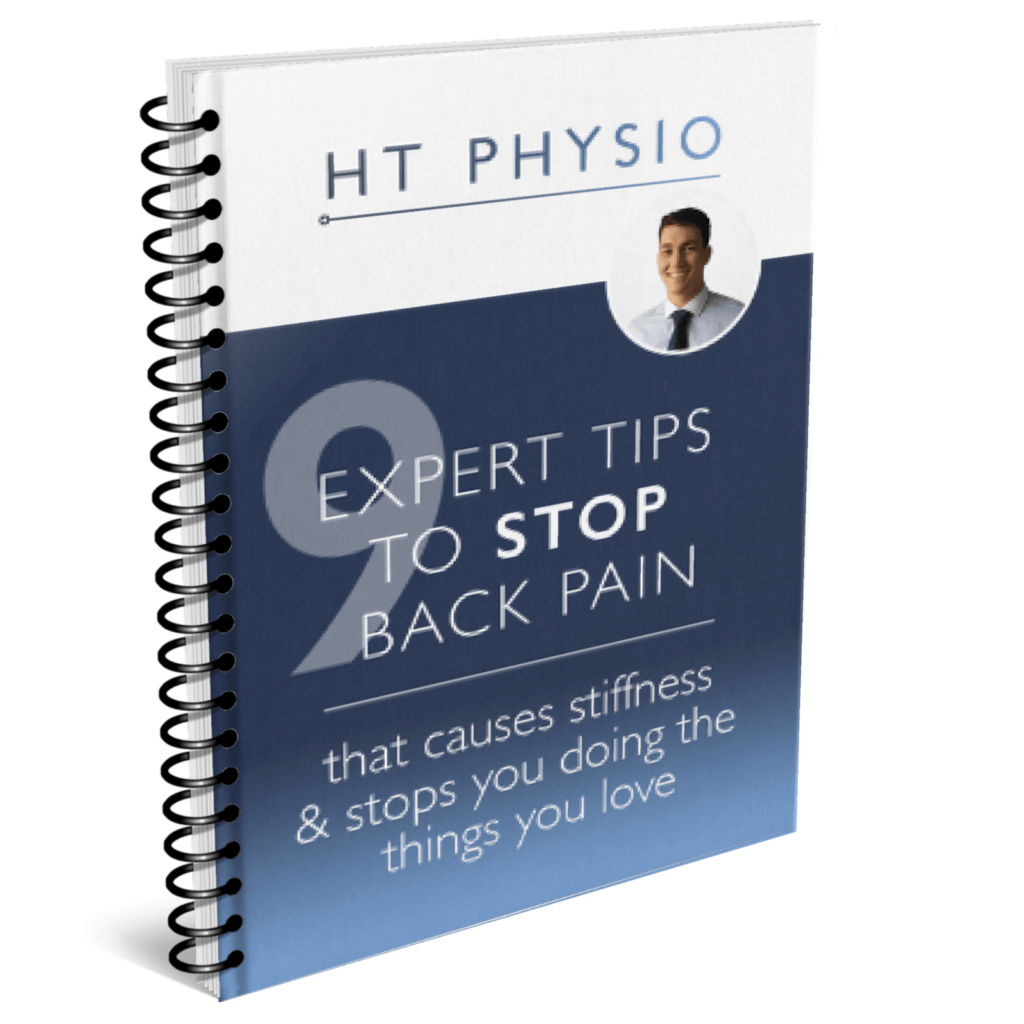While back pain doesn’t necessarily mean that there’s anything ‘serious’ wrong with your back, it can certainly be troublesome.
Back pain affects many of our clients – it can stop them from doing the things they love, make them feel 20 years older than they actually are and even threaten their independence and mobility. After years of working with people with stiff, sore backs, there are some habits that we’ve been able to identify that clearly make back pain more likely.
Knowing is half the battle – once you know what to avoid, and what to do instead, it’s possible to make back pain ‘melt away’, simply by tweaking a few parts of your daily routine.
Here, we talk about 5 daily habits that lead to back pain and how to avoid them.
Habit #1: Sitting for too long
It’s long been known that desk-based jobs are a risk factor for back pain. However, most of us spend a long time sitting every single day, even if we’re not at work!
One common myth is that perfectly adjusted ‘ergonomic’ chairs can prevent back pain – they can’t! Even if you hired the best scientists in the world to create the ‘perfect chair’, if you spent 8 hours a day sat in it, you’d probably still end up with back pain!
Back pain isn’t always just caused by a bad chair, or even bad posture. It’s usually caused by the short, tight muscles that develop in our legs and back from being in a sitting position for hours on end.
Short, tight muscles in the pelvis, legs and back pull on their bony attachments and pull the back out of kilter, making back pain more likely.
If you’ve been sat for a while, then when you stand up you feel tightness and tension in your legs and back, you’ll have experienced this phenomenon!
Action tip: You can remedy this problem by setting an alarm on your phone that goes off every 30 minutes when you’re sat down. Each time it goes off, stand up, take a walk, then come back to your chair. The difference between doing that and sitting in one place all day will be staggering!

Habit #2: Lifting awkwardly
Everyone thinks that you should always bend your knees when lifting something from the floor – but did you know that there’s not necessarily any single ‘harmful’ way of lifting something?
‘Awkward’ lifts can be described as any movement that your body isn’t used to performing regularly that puts weak muscles under tension and leaves you vulnerable to a strain, sprain or worse.
We picture the classic ‘awkward lift’ as someone bending and twisting as they pick a box from the floor. So why is it that some people get problems when they do this movement, while others can do it many times and be OK?
The answer is that there is a way you can build tolerance to these movements and improve your body’s capability of performing these actions over time.
Now, there is a right and a wrong way to go about doing this, so it’s definitely wise to get some advice from a qualified professional who can put a programme in place to improve your lifting capability – allowing you to bend, twist and lift from the floor without the fear of your back ‘going’!
Action tip: Get some advice from a qualified physio who can help you with your lifting technique so you can maintain the mobility of your spine for years to come!
Side note: If you’ve recently lifted something awkwardly and you’re thinking “Yes, this sounds like me!” then why not take our free back pain guide – 9 Expert Tips to Stop Back Pain that Causes Stiffness and Stops You from Doing the Things You Love – using the button below today.

Habit #3: Too much time on the mobile phone/iPad
The curse of the modern age! Social media and mobile phone apps are certainly to blame (in part) for the back pain epidemic in the developed world.
The problem, of course, isn’t the phone or iPad itself – it’s the posture that we find ourselves in when using them. Usually, we’ll be sat, hunched forward, over-working our postural muscles to hold the phone still. Being in this position for hours on end leads to tightness and weakness in various parts of the body and can cause back pain over time.
Using your phone or iPad stood up isn’t much better, either. The position our necks have to be in as we crane forward to look at the screen puts pressure on the entire spine and can be really uncomfortable, even when you put the phone down after.
Action tip: Be sure to have regular breaks from your phone and iPad, especially in the evenings where we tend to ‘scroll’ for hours on end on the sofa. If you can’t put the iPad down, make sure your neck and lower back are supported in your current chair and you don’t feel like you’re ‘straining’ your neck or shoulders in order to use the device.
Habit #4: Not getting enough sleep
There are direct links between a lack of sleep and an increased likelihood of suffering from a chronic low back condition.
In fact, the evidence mounting up against a lack of sleep is really alarming. A lack of sleep can lead to a heightened chance of suffering from depression and anxiety, which often leads to – you guessed it – back pain.
Sleep researchers recommend getting at least 8 hours of sleep per night. The most prominent sleep scientists are starting to advocate that even 7 hours of sleep is not sufficient, and some people need as many as 9 hours per night.
I listened to an interesting talk from a sleep specialist who stated that two of the tell-tale signs that you’re not getting enough sleep are the ‘3PM slump’, or feeling like you need to have more than 2 coffees to get through the day.
Action tip: There are many ways to improve your sleep. Some of the most effective include being sure to get enough exercise in the day (but not after 6PM), cut back on caffeine after midday, and keep your room cool (16C is ideal).

Habit #5: Ignoring aches and pains until it’s too late!
This last habit is one that we’re all guilty of.
We let an ache or a pain niggle away in the background for a few days, which then turns to a few weeks and before we know it, it’s led to a second problem.
This is actually one of the most common causes of back pain in the clients that come to see us – they developed a separate problem (a sore knee, for instance) which they initially ignored.
They then found that the knee problem caused them to begin to limp, maybe just slightly, but that limp was enough to affect the lower back.
Often, when people come to see us with a problem like this, their original problem has resolved… but the back pain has remained, and they have no idea what to do about it.
Action tip: You can avoid situations like the one I’ve described above by addressing seemingly small problems early! Get advice from a qualified professional who can intervene early and stop that niggle from becoming something more troublesome.
Summary
Although this list isn’t exhaustive, the 5 habits above are some of the most common causes of the back pain that we see in our clinic.
If you’re suffering from back pain that either came out the blue or has been there for a long time and isn’t shifting, there could be a problem with your movement that is stopping it from getting better!
At HT Physio, we’re currently offering 100% free “Movement MOT’s” for a limited time only, where you can come in and get a FREE 30-minute movement assessment from a back pain expert! We’ll tell you what’s causing your back pain and we’ll also tell you exactly what steps you need to take to fix it.
If you’d like to apply for one of a very limited number of these free sessions at our beautiful Farnham clinic, click the button below and we’ll get right back to you!



